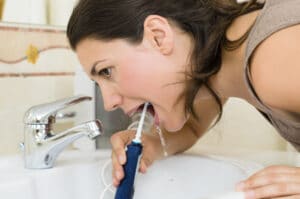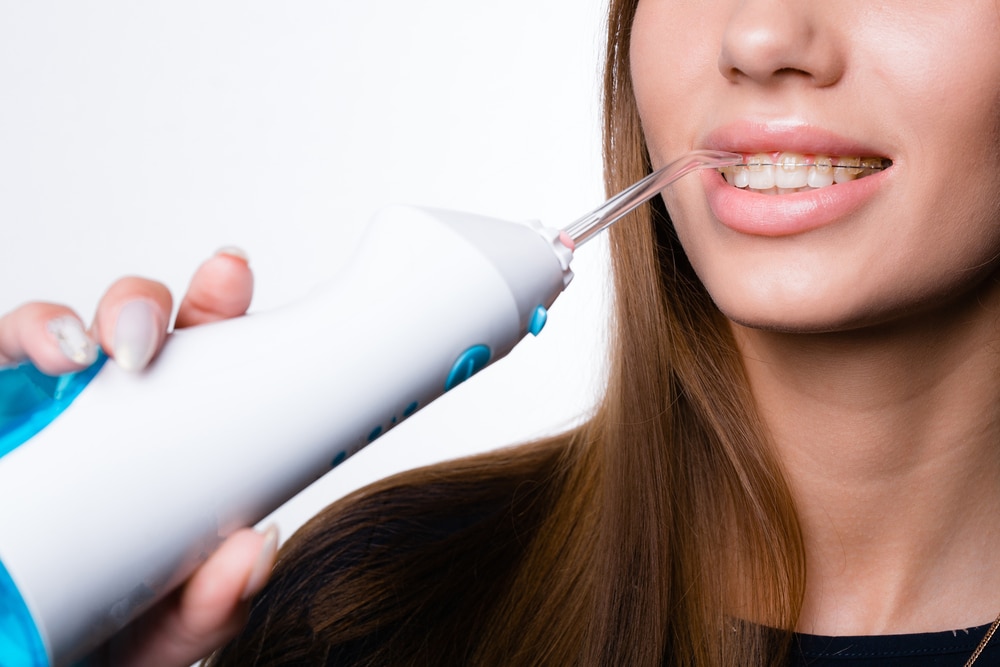Oral hygiene is incredibly important. You must make sure to have a daily hygiene routine to maintain the quality of your teeth and gums. Regularly brushing and flossing can also help keep your breath fresh, and give you a gleaming smile – who wouldn’t want that?
A simple device you can use to boost your oral health is a water flosser. These electric devices help remove food debris and bacteria effectively. However, not everyone understands how they work, or how to use them properly. As a result, we have created this short guide on how to use a water flosser for your benefit!
What Is a Water Flosser?
The technical term for a water flosser is an oral irrigation device, but you could also hear them being called Waterpiks. You could think of it as a small, portable shower head.
Essentially, the device directs a pressurised stream of water into your mouth. This jet of water is used to remove plaque and access hard-to-reach areas in your mouth that you might not be able to get at from brushing your teeth.
You may have seen dentists using these devices when performing a scale and polish or deep clean. Water flossers either have a water reservoir that you fill or connect directly to a water faucet.
They have the same function as standard dental floss but work in a different way that will take some getting used to.
View this post on Instagram
What Are the Benefits of Using a Water Flosser?
Now that you understand what a water flosser is, we can quickly discuss the benefits. It is important to realise that an oral irrigator is not a substitute for a toothbrush. Waterpiks are meant to be used in addition to your brushing routine. However, they can offer the following benefits:
- Effectively removes plaque, bacteria, and excess food
- Can reach areas that a typical toothbrush cannot
- Excellent for those with sensitive teeth and gums
- Perfect for cleaning dental implants, false teeth, and braces
Even a rigorous brushing of your teeth could leave food and bacteria behind. But water flossing can reach where your brush cannot, they can remove tough stains, and food debris.
These products are great for those with sensitive teeth and gums, too. If you have a sensitive mouth, using string floss may be uncomfortable and cause pain. Water flossers can help reduce this pain and still give you great oral care.
Finally, these devices are excellent for cleaning and flossing around dental fixtures such as braces, fillings, crowns, implants, and false teeth, where dental floss may be more difficult or impossible to use.
Using Your Water Flosser Effectively
So what is the best way to use an oral irrigator effectively? These devices are simple enough, but you must still take care, and understand what to do and what not to do. The following is a simple 6-step process of how to use an oral irrigator:
- Ensure the device has a clean lukewarm water source
- Set the pressure of the device and lean over the sink
- Place the tip in your mouth starting with molars at the rear
- Turn on, carefully follow your gum line and spend at least 2 seconds on each tooth
- Turn off, empty the reservoir
- Clean, dry, and store
Firstly, when using a water flosser, you must have a clean water source. Warm water is ideal – not cold, and not hot. Hot water could burn your gums, while cold water could make your mouth and gums sensitive. You may have to fill the water reservoir with lukewarm water, or you may have to connect the device directly to a faucet.
 Once this is done, you can set the water pressure of the device. To start, the water pressure should be at the lowest pressure setting. As you use the device, you can increase the pressure setting to a power that is effective but doesn’t cause pain. There is no “right” pressure setting – simply adjust it to something that feels comfortable.
Once this is done, you can set the water pressure of the device. To start, the water pressure should be at the lowest pressure setting. As you use the device, you can increase the pressure setting to a power that is effective but doesn’t cause pain. There is no “right” pressure setting – simply adjust it to something that feels comfortable.
Next, place the device into your mouth (make sure to lean over the sink to avoid spillage). It is best to start with your rear molars and work your way towards your front teeth. Also, direct the irrigator away from your gums and teeth. Once the device is switched on, you should carefully move it along each tooth, close to the gum line.
Pro-Tip: The main areas you want to direct the water at the gum line, and the gaps in-between each tooth. This is where the most plaque, food, and bacteria will form.
For each tooth, you should hold the flossing device for a minimum of 2 seconds to ensure a thorough cleaning. Repeat this process for each tooth on both the inside and outside. You could also consider rinsing your tongue and underneath where the tongue joins to your mouth. The entire process should take between 2-4 minutes.
It is important to empty the water once you have finished flossing. Bacteria will grow in stale water which will nullify the usefulness of the flosser completely! Also, you should clean the waterpik after each use. Fully rinse the water tank and water pipe and store it away for future usage.
Pro-Tip: Store your flosser away from the toilet or sink. This is a common mistake people make and these are the worst areas for germs in your bathroom.
Water Flosser FAQ
To give light to some doubts about water flossing, here are some commonly asked questions and our handy answers.
Is water flossing a substitute for standard dental floss?
Ideally, an oral irrigator should be used together with daily brushing, and should only substitute string floss if your dentist recommends it. Only if you learn how to use a water flosser correctly, will it be as effective as using dental floss.
Which situations are water flossers particularly useful?
These flossers are great for those who have braces, as food and plaque can often get stuck in difficult-to-reach places. They are also ideal for people who suffer from gum disease or bleeding gums.
Can a water flosser cause pain when using it?
These devices should not cause any pain and should be more comfortable than traditional dental floss. This makes an oral irrigator ideal if you have sensitive teeth or gums. If you ever experience any pain when flossing, then you should seek medical advice.
Do you use a waterpik before or after brushing?
There are pros and cons to flossing before and after brushing, with many factors to consider. Discuss with your dental hygienist which they recommend.
Do water flossers work?
Water flossers have been proven effective if used correctly and have received the American Dental Association (ADA) Seal of Acceptance.
Conclusion
We hope you have found this guide on how to use a water flosser beneficial. Water flossing can greatly improve your daily oral hygiene routine when done right. Once you understand how to use the device properly, you can benefit from healthier teeth, gums, and fresher breath!
Additional Resources
Paul is the type of person who never met a problem he couldn’t fix. He can always be found tinkering with something in his house, even if it isn’t broken! His tips and tricks are often shared on our site. He’s the one you call when something breaks because he has been known to improvise fixes for everything from leaky faucets to malfunctioning dryers.

